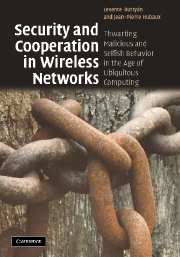 Security and Cooperation in Wireless Networks
Security and Cooperation in Wireless Networks Book contents
- Frontmatter
- Contents
- Preface
- Acknowledgements
- Part I Introduction
- Part II Thwarting malicious behavior
- 4 Naming and addressing
- 5 Establishment of security associations
- 6 Securing neighbor discovery
- 7 Secure routing in multi-hop wireless networks
- 8 Privacy protection
- Part III Thwarting selfish behavior
- Appendix A Introduction to cryptographic algorithms and protocols
- Appendix B A tutorial on game theory for wireless networks
- References
- Index
8 - Privacy protection
from Part II - Thwarting malicious behavior
Published online by Cambridge University Press: 05 June 2012
- Frontmatter
- Contents
- Preface
- Acknowledgements
- Part I Introduction
- Part II Thwarting malicious behavior
- 4 Naming and addressing
- 5 Establishment of security associations
- 6 Securing neighbor discovery
- 7 Secure routing in multi-hop wireless networks
- 8 Privacy protection
- Part III Thwarting selfish behavior
- Appendix A Introduction to cryptographic algorithms and protocols
- Appendix B A tutorial on game theory for wireless networks
- References
- Index
Summary
Privacy means that one can control when, where, and how information about oneself is used and by whom. Privacy is not about hiding one's personal information from everybody else in the world. In fact, revealing personal information to authorized parties under well-defined circumstances can be very useful and should be made possible. For instance, assume that someone suffers an accident and she is transferred to the hospital in an unconscious state. In this case, it is quite useful if the medical doctors can look up her medical record in a database.
It is clear, however, that we do not want that everyone can access our medical record. In particular, employers and insurance companies should not have access to it. However, the problem is that once personal information has fallen into the wrong hands, we cannot control its use anymore. Therefore, hiding personal information from unauthorized parties is indeed very important. This is one of the most powerful (and sometimes the only) means to retain control.
Privacy is a problem that cannot be solved solely by technical means. For instance, there is no technical solution that guarantees that a misbehaving doctor cannot reveal sensitive medical data to an unauthorized party (e.g., an employer). Therefore, the problem is usually addressed with a combination of technical and legal means. In fact, the technical and the legal approaches can nicely complement each other. Problems that cannot be solved technically are often related to human behavior.
- Type
- Chapter
- Information
- Security and Cooperation in Wireless NetworksThwarting Malicious and Selfish Behavior in the Age of Ubiquitous Computing, pp. 237 - 272Publisher: Cambridge University PressPrint publication year: 2007
- 1
- Cited by


